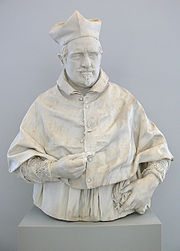
Giuliano Finelli
Encyclopedia

Italy
Italy , officially the Italian Republic languages]] under the European Charter for Regional or Minority Languages. In each of these, Italy's official name is as follows:;;;;;;;;), is a unitary parliamentary republic in South-Central Europe. To the north it borders France, Switzerland, Austria and...
Baroque
Baroque
The Baroque is a period and the style that used exaggerated motion and clear, easily interpreted detail to produce drama, tension, exuberance, and grandeur in sculpture, painting, literature, dance, and music...
sculptor who emerged from the workshop of Bernini
Gian Lorenzo Bernini
Gian Lorenzo Bernini was an Italian artist who worked principally in Rome. He was the leading sculptor of his age and also a prominent architect...
.
He was born in Carrara
Carrara
Carrara is a city and comune in the province of Massa-Carrara , notable for the white or blue-grey marble quarried there. It is on the Carrione River, some west-northwest of Florence....
to a family of marble masons in a town associated with mining of the stone, and he initially trained with Michelangelo Naccherino. He was active in Bernini's studio for a few years, but he broke with Bernini in 1629, when he felt slighted by the awarding of the choice commission of a Saint Helena statue for the crossing of St Peter's to Andrea Bolgi
Andrea Bolgi
Andrea Bolgi was an Italian sculptor responsible for several statues in St. Peter's Basilica, Rome. Towards the end of his life he moved to Naples, where he sculpted portrait busts.-Early life:...
. He is also purported to have also been slighted by failure to be recognized as the detail master behind the Apollo and Daphne
Apollo and Daphne (Bernini)
Apollo and Daphne is a baroque life-sized marble sculpture by Italian Gian Lorenzo Bernini housed in the Galleria Borghese in Rome.It depicts the climax of the story of Daphne and Phoebus in Ovid's Metamorphoses...
statue of Bernini. For some time, he found occasional work, often with the support of Pietro da Cortona
Pietro da Cortona
Pietro da Cortona, by the name of Pietro Berrettini, born Pietro Berrettini da Cortona, was the leading Italian Baroque painter of his time and also one of the key architects in the emergence of Roman Baroque architecture. He was also an important decorator...
.
The difference between the two sculptors, Bernini and Finelli, was slight. Finelli is highly meticulous about carving tiny details, a focus which often seems to drain from the greater emotion of the piece. The prolific Bernini was less conscious of lacy frillery in dress, and more centered on the psychology. The contrast can be seen in their portraits of a common patron, Cardinal Scipione Borghese
Scipione Borghese
Scipione Borghese was an Italian Cardinal, art collector and patron of the arts. A member of the Borghese family, he was the patron of the painter Caravaggio and the artist Bernini...
. Bernini's portraint is animated, while Finelli's is more sober and has a slight downgaze. He also completed the image of Cardinal Giulio Antonio Santorio (c. 1630) at San Giovanni in Laterano.
Within a few years of leaving the employ of Bernini, Finelli left for Naples
Naples
Naples is a city in Southern Italy, situated on the country's west coast by the Gulf of Naples. Lying between two notable volcanic regions, Mount Vesuvius and the Phlegraean Fields, it is the capital of the region of Campania and of the province of Naples...
with his pupil and nephew, Domenico Guidi
Domenico Guidi
Domenico Guidi was a prominent Italian Baroque sculptor.Born in Carrara, Guidi followed his uncle, the prominent sculptor, Giuliano Finelli to Naples. As the nephew of a sculptor noted for his feud with Bernini, it is not surprising that Guidi was never employed by the eminent master...
. He is known best for a number of portraits and statues in the cathedral of San Gennaro
Cathedral of Naples
Naples Cathedral is a Roman Catholic cathedral, the main church of Naples, southern Italy, and the seat of the Archbishop of Naples. It is widely known as the Cattedrale di San Gennaro, in honour of Saint Januarius, the city's patron saint, but is actually dedicated to the Assumption of the...
in Naples. In Naples, he had to compete with the sculptor Cosimo Fanzago
Cosimo Fanzago
Cosimo Fanzago was an Italian architect and sculptor, generally considered the greatest such artist of the Baroque period in Naples, Italy.-Biography:...
for commissions.
Finelli died in Rome in 1653 of reasons unknown.
Sources
- Connors, Joseph.Review of Jennifer Montagu, Baroque smoke Sculpture: The Industry of Art, New Haven and London, 1989, in The New York Review of BooksThe New York Review of BooksThe New York Review of Books is a fortnightly magazine with articles on literature, culture and current affairs. Published in New York City, it takes as its point of departure that the discussion of important books is itself an indispensable literary activity...
- Finelli gallery at Web Gallery of Art

